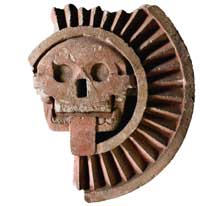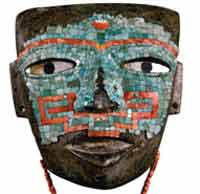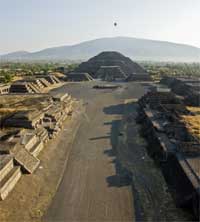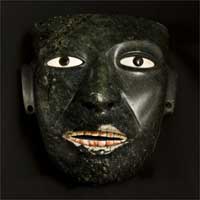Beauty and death in a secret society
by Laura Angela Bagnetto
Article published on the 2009-10-09 Latest update 2009-10-12 13:47 TU
Take a trip back in time - a total of 2009 years - through the Avenue of the Dead to the Quai Branly museum in Paris to find a secretive society, whose gods required human blood and whose craftsmen produced stunning works of art - the Teotihuacan people.
Culture in France: Teotihuacan, the place where gods are born
Teotihuacan was an ancient, peaceful civilization that spanned 750 years, from 100 years before Christ to 650AD, in what is now central Mexico.
Not much is known about this culture, but over the past century, archaeologists have been unearthing some amazing artifacts that are on show at the Quai Branly today.
The man who first thought of the show will never see it. He was field archaeologist Felipe Solis, who tragically died of a heart attack less than a month before it opened in Mexico City. The Quai Branly exhibition is dedicated to him.
"The Teotihuacan was the greatest culture in central Mexico," says curator and archaeologist Miguel Baez Perez. "The Teotihuacans knew how to write but didn't want to show the public anything. There's always controversy about the Mesoamerican cultures in the world, because there's this idea if they don't have writing systems, they are a little bit savage."
Judging by this exhibition, they were anything but uncivilised, if you overlook a penchant for human sacrifice. The civilisation spanned more than 750 years without disruption, something unheard of in Mesoamerica.
In the centre of the show is an architectural scale model of the city, which was divided into four quadrants, with the Avenue of the Dead running east-west through the city.
"We archaeologists think that every quarter had a governor and they went together as a four government party and they took the decisions for all the city," says Baez Perez.
"When you have several governors there is not one who can pop up and say 'I'm more important'. That's the main theme around this exhibition, this anonomity, this cult for the ancestors. It seems to be a very smooth culture. They were not like that but that was the image they wanted to give."
Teotihuacans were excellent craftspeople who used the rocks around them, such as obsidian and pyrite and even human bones, to create tools to make intricate bas-relief bowls, jewelry and stone death masks.
"There are some earpieces here that are from greenstone that are manufactured and they have a certain shine. It is really compelling just to see them," says Diego Sapien, the project co-ordinator for the exhibition.
"They didn't have any type of tool to make them. So this is all limed with a stone, with water, and you have to make this kind of stone and this kind of stone is particularly hard," he adds.
Art that adorned the buildings and temples of Teotihuacan is featured throughout the show, including a showstopping piece made entirely from stone, featuring a skull in the centre of a circle that was placed on the pyramid of the sun, the biggest building in town.

God of Death, from the the Instituto Nacional de Antropología e Historia, Mexico
(Photo: Martirene Alcantara)
This is the god of death, inside the sun. For Teotihuacans, the god of death needed blood because the sun does not go up and go down in the day, but is burned in the morning and dies at night, according to Baez Perez. He says that this symbol is a common one among Mesoamerican peoples who span from central Mexico down to Belize and Honduras.
Teotihuacans and other Mesoamerican peoples made human and animal sacrifices to their gods. The skull's tongue is hanging out of his mouth to signify that he needs blood to get the sun moving, says Baez Perez.
"If you look very carefully, you will see that even though he seems to be a skull he's still got skin and flesh. He's got gums, for instance, so he's rotten. Because from all that rots, comes life. From everything that rots, a tree, a plant an animal, that grows life again," he adds.
Baez Perez says that this was the legacy that Teotihuacans left for all other cultures.
"It gives you another sense of the sun and the moon. We are in such a world of changes about the climate and about what we fear about changes of our world," says Jean, a Parisian museum-goer.
"I believe this exhibition presents beliefs of a world that had other concerns about their land and about their planet. It's both enchanting and interesting," he adds.
Baez Perez speaks of one aspect of the collection that has nothing to do directly with the Teotihuacans, but the influence they had after their demise. He suggests that perhaps the first archaeologists who worked in Mexico were the Aztecs, a Mesoamerican civilization that came 800 years after the Teotihuacans.
"Aztecs wanted to create their own history, saying that they were Teotihuacans, but they weren't," says Baez Perez.
One example at the exhibition is a funerary mask made from diorite, a green stone common to the area. The mask was not found at the site of the Teotihuacans, who were 35 kilometres from the Aztec empire, but in Mexico City at the Templo Major.
"It's amazing," says Baez Perez.
The Teotihuacans came to an end in 650 AD. No one is sure why they ceased to exist, but historians have documented an exodus of people from the area.
Sapien, the project co-ordinator for the exhibition, told RFI that it is worth the price of the ticket to see the 450 pieces assembled. This is the largest exhibit ever of these artifacts, and the first time they have been brought together in Europe.
"Many people have gone to Teotihuacan, and know the city, but in the city you don't get to see the pieces around it or the complete way or feel of how Teotihuacan was, because it's in ruin," says Sapien.
"I've been to Teotihuacan, and you see the magnificence of the pyramids but not the detail and the way of life of the Teotihuacan people like you see here in the exhibition," he adds.
Artifacts including pottery, painted murals, and even highly decorated drainpipes await visitors at Teotihuacan: the place where gods are born.
Culture in France: Teotihuacan, the place where gods are born
Culture
Cracking skulls!
2010-02-15 12:35 TU
France's gothic avant-garde
2010-02-13 15:16 TU
Winter sounds warm up French jazz fans
A tribute to trumpeter Don Cherry at a Free Jazz showcase festival outside of Paris.
2010-01-31 11:55 TU
Trance on a trapeze
2010-01-30 12:41 TU
Retro Mobile - classic car exhibition
260,500 euros for rusty old car found at bottom of lake
A rusty old Bugatti, which spent years at the bottom of a Swiss lake, sold for 260,500 euros at the Retro Mobile classic car exhibition on Saturday. Other more lovingly-restored pristine examples are exciting enthusiasts from across the world in a special anniversary event at Porte de Versailles in Paris.
2010-01-23 20:21 TU
France's changing face looks east
2010-01-22 16:17 TU
Putting art on film
2010-01-20 13:09 TU
What sex is a coffee bean, where does the aubergine come from?
2010-01-08 16:08 TU
Cocteau Twin flying solo
2010-01-06 16:43 TU
A taste of Nordic filmmaking in Paris
Ciné Nordica 2009 at Paris’s Panthéon cinema showcases filmmaking from Scandinavia. So what makes Nordic film different from the rest?
2009-12-22 17:15 TU

















